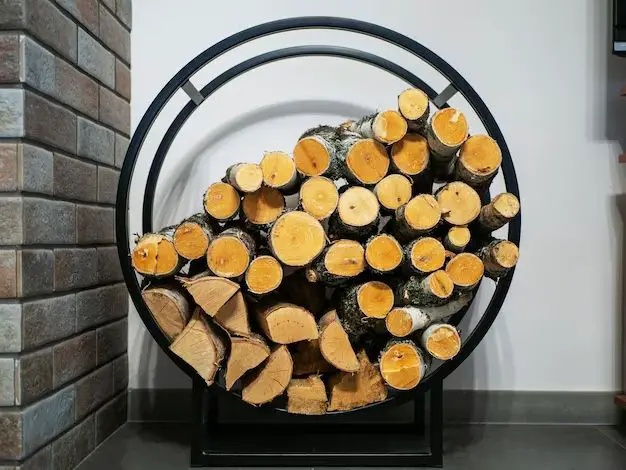Having an organized and functional firewood storage system is an important consideration for any home with a wood-burning fireplace or stove. While a firewood rack may seem like an unnecessary accessory, there are several clear benefits that make investing in one worth it for most homeowners.
Page Contents
Keeping Firewood Dry
One of the primary purposes of a firewood rack is to keep wood properly stored and dry. Wet or damp firewood simply does not burn as well, and trying to burn wet logs can create excess smoke and creosote buildup in your chimney. A good firewood rack elevates the wood off the ground and allows air circulation underneath and around the logs so they can fully dry out before being burned. Models with roofs or covers provide extra protection from rain, snow, and other excess moisture.
Organization and Accessibility
A quality firewood rack also brings much-needed organization to firewood storage. Neatly stacked logs are easier to access when it’s time to light a fire, and an organized setup allows you to easily see when supplies are running low. Having wood within easy reach, rather than scattered around the yard, also makes the process of bringing it inside much simpler. No more climbing over messy woodpiles or digging through snowdrifts to find usable logs.
Space Savings
Carefully stacking firewood on a rack helps save space compared to simply piling logs on the ground. And vertical designs that hold wood off the ground allow you to stack more wood in the same amount of space. This is especially beneficial for those with small yards or limited outdoor storage options. A firewood rack on a deck or patio can hold enough wood for the season without eating up too much valuable room.
Pest Control
Keeping firewood neatly stacked on an elevated rack helps deter pests like termites, ants, and spiders from inhabiting the logs. Scattered pile of wood on the ground can become infested with insects and other undesirables that you certainly don’t want to bring inside. A firewood rack allows for full visibility and accessibility so you can remove any problem logs before they ever make it to your fireplace.
Aesthetic Appeal
Lastly, a neatly organized firewood rack simply looks nicer than a messy woodpile. Choose a rack made from attractive materials like weathered wood, galvanized steel, or wrought iron that complements your home’s architecture and outdoor living spaces. Stacked firewood can even become an interesting landscape feature when displayed properly on a handsome rack. Place it near outdoor gathering areas so you’ll have logs handy for fire pits or chimeneas.
Key Considerations
When shopping for a firewood rack, keep the following considerations in mind:
- Material – All-weather materials like powder coated steel, cedar, redwood, and composite resist rot, rust, and decay.
- Capacity – Make sure the rack can hold the amount of firewood you’ll need for the season.
- Covered vs. uncovered – A waterproof cover protects wood from the elements but can limit airflow.
- Mobility – Some racks are stationary while others have wheels for portability.
- Footprint – Consider the rack’s dimensions to ensure it will fit in your intended space.
- Price – Firewood racks range widely in price from $50 up to $500+ depending on size, materials, and features.
Ideal Firewood Rack Uses
A high-quality firewood rack excels in the following applications:
- Covered outdoor storage – Keeps wood dry under a roof or waterproof canvas cover.
- Open-air outdoor storage – Allows airflow to dry wood while elevating it off the ground.
- Small space storage – Compact vertical designs maximize capacity in tight areas.
- Movable storage – Portable racks with wheels can be shifted around seasonally.
- Permanent installations – Large custom racks hold firewood right where you need it.
- Deck and patio storage – Multifunctional racks enhance outdoor living areas.
Firewood Rack Styles
Firewood racks come in a diverse range of styles to suit any need. Popular options include:
| Style | Description | Benefits |
|---|---|---|
| Vertical | Tall, narrow racks that hold wood stacked perpendicular to the ground. | Maximizes capacity in small footprints. Promotes airflow around logs. |
| Horizontal | Low, long racks that hold wood laid flat and parallel to the ground. | Makes loading/unloading wood easy. Often includes space underneath for tools. |
| Lean-to | Angled rack that leans logs against a wall or fence. | Saves space against existing structures. Usually uncovered. |
| Enclosed cabinet | Box-like storage with a door to conceal/protect wood. | Keeps wood completely covered and hidden. Requires bringing wood outside before use. |
| Mobile | Rack with wheels for easy portability. | Allows seasonal relocation. Quick access to wood for outdoor fire features. |
DIY Options
For the handy DIYer, there are many options for building your own custom firewood rack to perfectly suit your space and needs. Simple designs can be created using basic materials like:
- Cedar planks or landscape timbers
- Treated 4×4 posts
- Galvanized pipe
- Cinder blocks
- Scrap lumber
- Metal fencing
Make a basic rack as narrow or wide as desired and add design features like shelving, tool storage, or a lid. Just be sure to use weather-resistant materials that will hold up outdoors.
Conclusion
Investing in a high-quality firewood rack is one of the best ways to keep wood dry, organized, and easily accessible for your fireplace or wood stove. The right storage solution saves time and energy while adding function and visual appeal to your outdoor space. Take into consideration your climate, yard size, storage needs, and budget to select the ideal firewood rack for your home.
